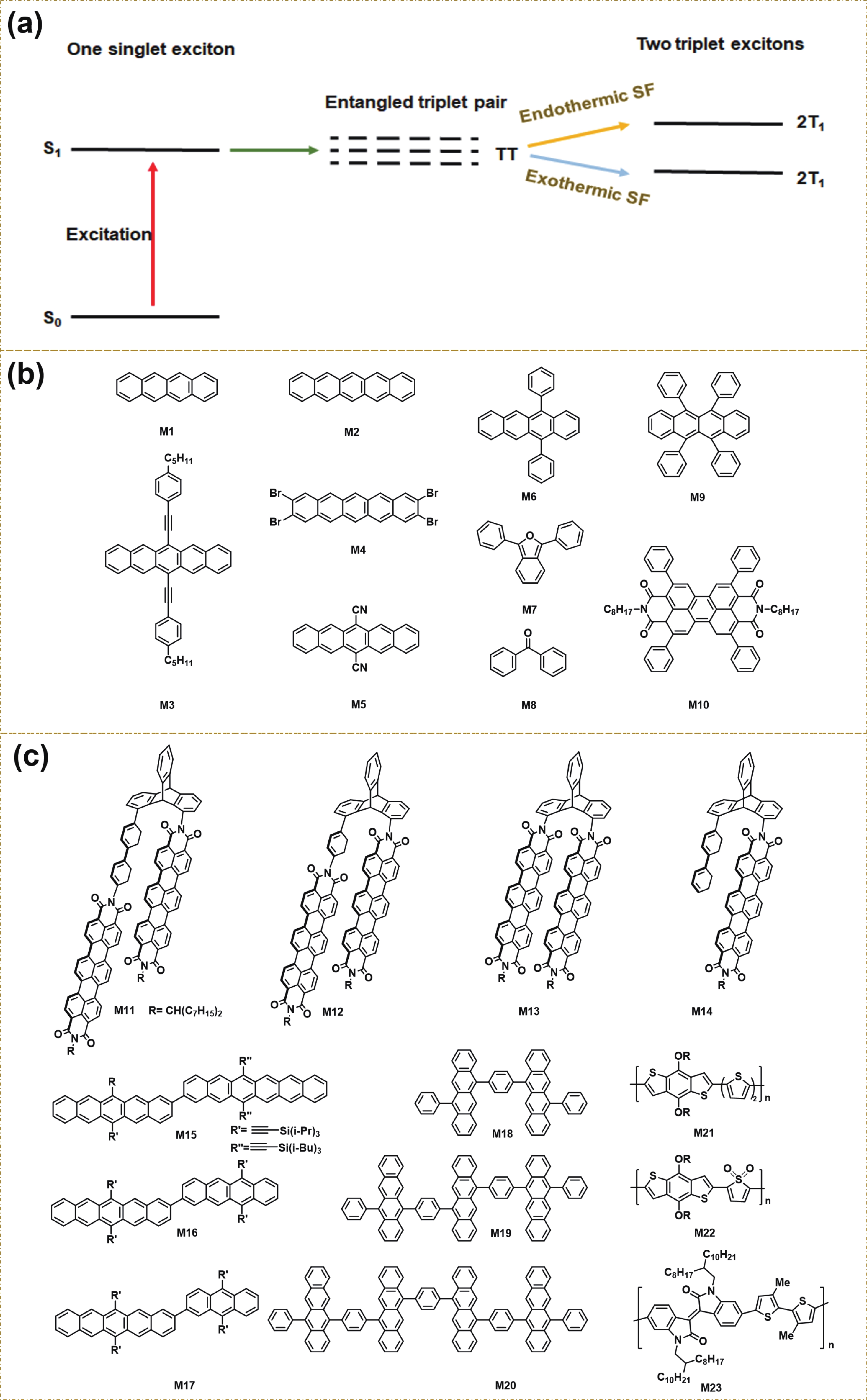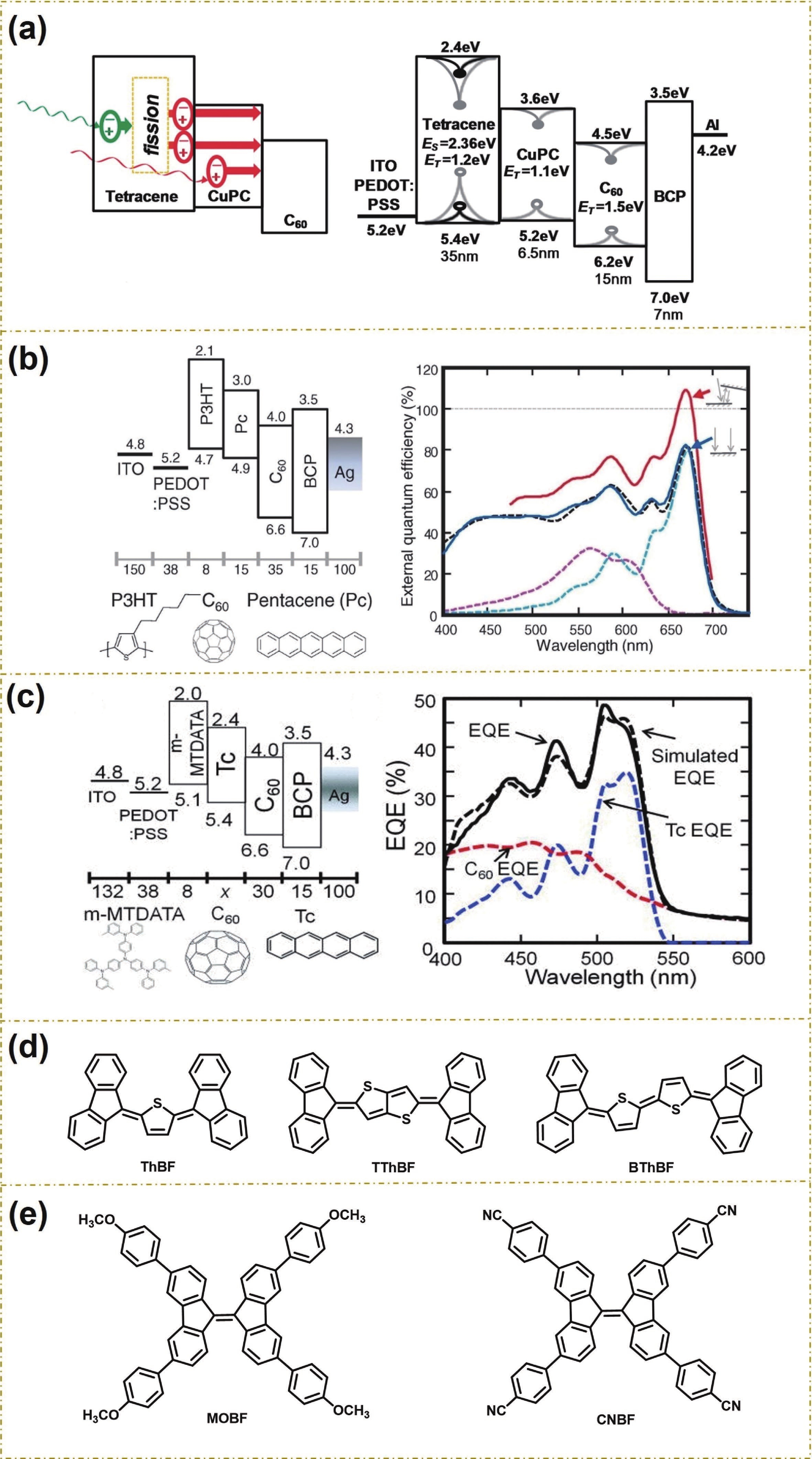Enhancing the power conversion efficiency (PCE) is the major task in the development of solar cells[1-5]. In 1961, William Shockley and Hans J. Queisser pointed out that the highest PCE for a single-junction solar cell is limited to 31% due to the thermalization and transmission losses[6]. Singlet fission (SF) is an appealing carrier-multiplication approach to break the Shockley-Queisser limit, since it converts one high-energy singlet exciton into two low-energy triplet excitons. Thus, one absorbed photon generates two electron–hole pairs.
SF phenomenon was first observed in anthracene single crystals in 1965[7]. It attracted attention again in 2006[8, 9]. In organic semiconductors, a singlet exciton (S1) forms after the absorption of a photon. If the energy of this singlet exciton is greater than twice of that for triplet exciton (T1), namely E(S1) > 2E(T1), then spin-allowed fission (S1 → 2T1) could occur[10]. The general kinetic model for SF process is:
|
S0+S1→1(TT)→T1+T1, |
(TT) |
where S0 is the ground state, S1 is the excited singlet state, 1(TT) is the intermediate state of a correlated triplet pair, and T1 + T1 are two independent triplet states (Fig. 1(a)).

The application needs materials with high fission efficiency, suitable bandgap for capturing high-energy photons, appropriate triplet energy and high chemical stability[11, 12]. Owing to the existence of competitive pathways (i.e. S1 to S0 relaxation in picosecond–nanosecond timescale; excimer formation in femtosecond timescale; charge transfer (CT) process in femtosecond timescale[10]), SF needs to occur in picosecond or sub-picosecond timescale. Thus, SF requires strong intermolecular coupling. The intermolecular coupling can be realized via Van der Waals force, weak non-bonded interactions and so on[13]. The coupling distance not only affects SF rate and triplet yield, but also influences the lifetime and diffusion length of triplet excitons.
Acenes with ordered packing are the most studied SF materials[14-17]. Tetracene (Fig. 1(b), M1) has gained great attention due to extremely high fission yield (η ≈ 200%) and slow dynamics (≈10–100 ps), although its SF activation energy is high[18]. For pentacene (Fig. 1(b), M2), the singlet exciton (S1) energy is 1.83 eV, which is more than twice the triplet (T1) energy (2 × 0.86 = 1.72 eV), making pentacene one of the most promising candidates for SF application[19]. Unfortunately, tetracene and pentacene show poor solubility, and they are instable in the presence of light and oxygen[20]. To solve these problems, scientists introduced 4-pentylphenylethynyl groups[21] (Fig. 1(b), M3), halogens[22] (Fig. 1(b), M4), cyano groups[23] (Fig. 1(b), M5), etc. to the frameworks of tetracene and pentacene to improve their solubility and stability. Among them, 5,12-diphenyl tetracene (DPT) (Fig. 1(b), M6) reported by Bradforth et al. is the first molecule showing high SF efficiency in amorphous film. They thought that the configuration of DPT pairs facilitated SF[24]. Besides, the crystals of 1,3-diphenylisobenzofuran[25] (Fig. 1(b), M7), benzophenone[26] (Fig. 1(b), M8), rubrene[27] (Fig. 1(b), M9) and perylene[28] (Fig. 1(b), M10) have also shown high SF efficiency.
In the above cases, the triplet excitons are generated through intermolecular packing within molecular aggregates or crystals. In this regard, materials capable of intramolecular SF could be more conducive for photovoltaic application. There are two advantages for intramolecular SF: (1) the distance between two chromophores is limited inside one molecule, leading to strong coupling of the chromophores and enhanced generation of 1(TT) state; (2) it excludes the influence of intermolecular packing, making SF an inherent property of the molecule. Intramolecular SF is useful for kinetics and mechanism studies.
Covalently linked dimers are typical materials that could undergo intramolecular SF. In a covalently linked dimer, the orbitals of the chromophore can overlap with that of the linker. This is more remarkable when possessing conjugated linkers, where the π orbitals of the linker are effectively mixed with that of the chromophore. Therefore, in addition to the through-space coupling, the through-bond electronic coupling provided by the linker facilitates intramolecular SF[11]. Another advantage is the easy control of the dielectric environment around the dimer, which is particularly useful for determining CT state. A number of studies have proposed a step-wise mechanism for SF, in which the CT state would temporarily appear in the formation of 1(TT)[29]. In crystals or aggregates, it’s almost impossible to analyze the dielectric environment. For covalently linked dimers, the dielectric environment can be easily adjusted by changing the solvents with different polarities (or dielectric constants), which helps to determine CT state energy[30]. Wasielewski et al. found that changing solvent polarity led to different CT state energy, which can either promote or inhibit the SF for terrylenediimide dimers[31] (Fig. 1(c), M11–M14). Furthermore, changing the combination of chromophores in dimers could also systematically adjust the singlet and triplet energies, thereby controlling intramolecular SF process. Campos et al. developed a series of heterodimers comprising a pentacene and another acene[32] (Fig. 1(c), M15–M17). They found that the singlet energies in these molecules are determined by the lower-energy chromophore, and the recombination of triplet pairs follows the energy gap law. Besides the dimer, longer oligomers with three or more chromophores also bring new insights on the mechanism of intramolecular SF. Xiao et al. designed a series of covalently linked tetracene oligomers (dimer, trimer and tetramer) (Fig. 1(c), M18–M20). They proposed that longer oligomers would experience a spatially separated TT state (denoted as
Polymers could also make intramolecular SF. In 2015, Sfeir et al. reported “donor–acceptor” (D–A) conjugated polymers with strong-acceptor and strong-donor building blocks. When changing thiophene unit in PBT2 (Fig. 1(c), M21) to thiophene-1,1-dioxide (TDO) unit with high electron affinity and relatively low triplet energy, the resulting PBTDO1 polymer (Fig. 1(c), M22) showed a high fission yield of 173 ± 10% and fast formation of triplets[34]. For the polymers with low CT character, the singlet state decays without forming a triplet state. However, strong CT character can yield charge separate state (CS) and reduction of SF. Therefore, electronic factors need to be fully considered for achieving high SF efficiency in polymers. In 2018, Xia et al. demonstrated a D–A polymer IIDDT-Me with high triplet yields of 160%–200%[35] (Fig. 1(c), M23). The quinoidal resonance structure of the strong electron-withdrawing unit isoindigo effectively reduces bond length alternation and leads to low-energy electronic states. No parasitic process in competition with SF was observed.
The application of SF in organic solar cells (OSCs) was investigated. Musgrave et al. suggested that 1(TT) is a dark singlet state with multi-exciton character because absorption of a photon from the ground state to this state is dipole-forbidden[36]. Thus, SF itself could not enhance the PCE. Compared with an OSC material with the same Eg, the SF material might double the photocurrent (Iph) but lose half of the open-circuit voltage (Voc)[10, 37]. On the other hand, low-bandgap OSC materials are often required to enhance the PCE[38, 39]. Ideally, Eg of low-bandgap OSC material is half of that for SF material. Thus, the high-energy photons can be absorbed by SF material and produce two low-energy triplet excitons, meanwhile the low-energy photons can be absorbed by low-bandgap OSC material and produce more excitons. As a result, the thermalization losses can be reduced. In 2010, Friend et al. used transient absorption spectroscopy to investigate SF process in pentacene/C60 bilayer system. After light striking, the triplet excitons were generated within 200 fs, and charge carriers were generated within 2–10 ns. These results indicated that the charge generation occurred after the triplet excitons diffusing to the interfaces, thus confirming the feasibility of applying SF to OSCs[40]. In 2011, Baldo et al. first reported OSCs combined with SF. A layer of copper phthalocyanine (CuPC) was inserted between tetracene and C60 layers (Fig. 2(a)). Tetracene absorbs <550 nm photons. After singlet fission in tetracene, two triplet excitons with energy E(T1) = 1.2 eV diffuse through CuPC (triplet energy 1.1 eV) and reach CuPC/C60 interface to dissociate. This result proved that OSC materials with a lower E(T1) and a similar HOMO level as compared to SF material could effectively use the multiplied excitons, which can be effectively converted into current[41]. In 2013, they introduced poly(3-hexylthiophene) (P3HT) as exciton-confinement layer between pentacene and PEDOT:PSS (Fig. 2(b)). When using C60 as the acceptor, external quantum efficiency (EQE) of 109 ± 1% and internal quantum efficiency (IQE) of 160 ± 10% at 670 nm were observed. The IQE of pentacene is about twice of that for other systems, since singlet excitons produced in P3HT could transfer to pentacene and turn into triplet excitons. In contrast, the highest EQE is only 24% for the device without P3HT. P3HT prevents triplet excitons in pentacene from contacting the anode and assists hole extraction in pentacene[37]. They also incorporated tetracene into the device (Fig. 2(c)). A peak triplet yield of 153% ± 5% with an IQE of 127% ± 18% was obtained. Because of the slower SF process, tetracene shows a lower triplet yield than pentacene. This indicates that materials with an exothermic SF process are more favorable[42]. In most π-conjugated systems, E(T1) is higher than E(S1). It was found that E(T1) could be lowered by increasing the biradicaloid character of the molecules[43]. In 2016, Kido et al. reported three non-polycyclic SF materials (ThQs, Fig. 2(d)) with a biradicaloid character. These materials were used as donors in solar cells to match with acceptors with different LUMO levels. EQE spectra indicated that the excitons dissociated into charge carriers with the acceptor PDIF-CN2 but not with C60, as ECT for ThQs/C60 is higher than E(T1) of ThQs[44]. Two 9,9-bifluorenylidene derivatives, p-type material MOBF and n-type material CNBF (Fig. 2(e)), were also synthesized and applied in OSCs[45]. In MOBF and CNBF, two fluorene units are connected through a double bond and display a twisted angle of 31°. The twisted structure endows the compounds a biradicaloid character, and T1 is about half of S1 energy level (E(S1) = 2.16 eV, E(T1) = 0.91 eV). Solar cells based on MOBF showed positive dependence of photocurrent on magnetic field, suggesting that SF took place.

In short, SF-enhanced OSCs face issues like the lack of SF materials and the instability of them. To improve the PCEs, it is necessary to develop more suitable SF materials and to understand the mechanism associated to the extraction of triplet excitons. Acceptors with suitable energy levels, high-performance triplet diffusion blocker and effective charge carrier extractors are desired.
Acknowledgements
H. Zhang thanks the National Key Research and Development Program of China (2017YFA0204903), National Natural Science Foundation of China (51733004, 22005128, 22075117, 22073038), 111 Project and the Fundamental Research Funds for the Central Universities (lzujbky-2020-44, lzujbky-2021-sp59). L. Ding thanks the open research fund of Songshan Lake Materials Laboratory (2021SLABFK02), the National Key Research and Development Program of China (2017YFA0206600) and the National Natural Science Foundation of China (51922032, 21961160720).





 DownLoad:
DownLoad:




 DownLoad:
DownLoad:

















